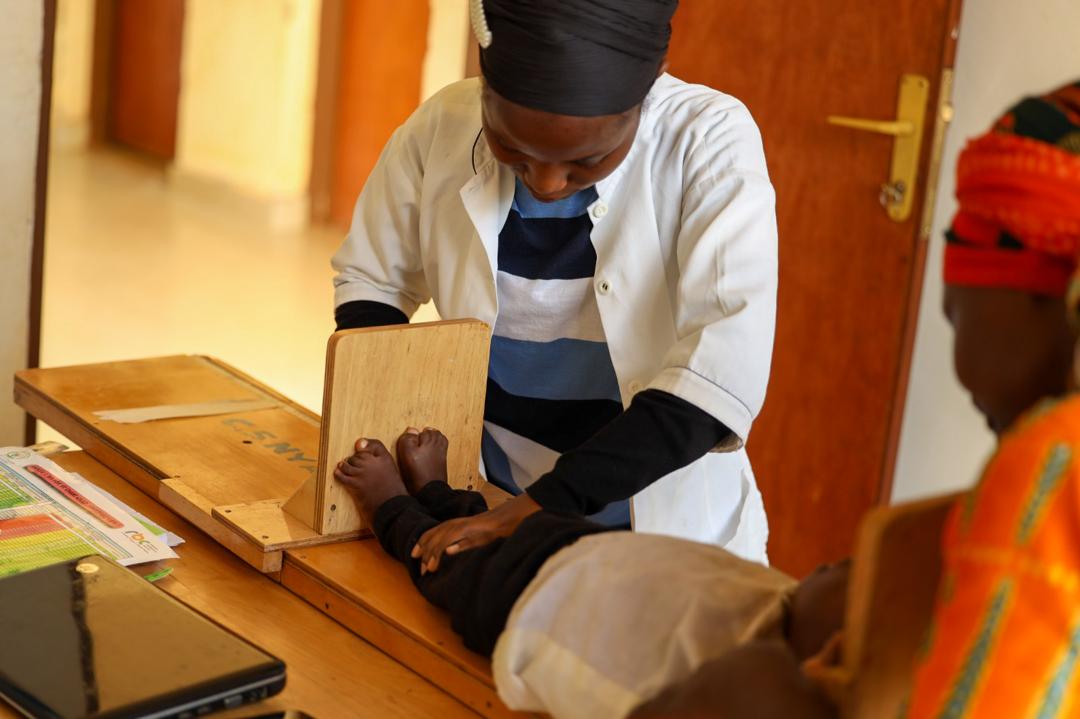Battling malnutrition in Rwanda: How a WHO software empowers nutritionists to improve children’s health in Ngororero and Rutsiro District

Nestled amidst Rwanda’s rolling hills lies the Ntaganzwa Health centre, in Ngororero District, a facility that caters for more than 3 000 children under five years. Mado Ishimwe, a 27-year-old nutritionist, recounts how she used to struggle to manually record children’s weights and heights using paper forms and faced difficulties analyzing the data using many charts, while a line of 20 more children waited for her. But now a new player has entered the fight against malnutrition: World Health Organization (WHO)’s AnthroPlus software, designed to facilitate the monitoring of the growth of children.
Under the scorching afternoon sun, a mother, cradling her one-year-old son, arrives for their eagerly anticipated monthly visit. Mado receives them and starts measuring the height of the child. With just a few keystrokes on her laptop, she logs the child’s measurements, and the app instantly processes and displays the essential indicators to show the progress in the growth of the child. “No more slow manual calculations. No more errors,” says Mado as she navigates through the software on her laptop. WHO AnthroPlus allows nutritionists to record the child’s growth (height, weight) at every visit and offers analysis of key indicators that allow easy tracking of the child’s nutritional status. “Before the app, I had to do all these calculations manually, but now the app does it for me!”

The Rwanda Demographic Health Survey in 2019-2020 revealed that 1 out of 3 children under 5 years are stunted, i.e. they are shorter than they should be for their age due to poor nutrition. The Western and the Northern provinces had the highest burden of stunting, with the districts of Ngororero and Rutsiro registering a stunting prevalence of 50.5% and 44.4% respectively. In February 2023, a baseline survey conducted by WHO across 27 health facilities and 426 households in Ngororero and Rutsiro districts revealed that only 25% of children in Ngororero district achieved the minimum acceptable diet (MAD), while a scant 20% of children in Rutsiro district met the MAD criteria.
Informed by the results of the survey, WHO, in collaboration with the World Food Programme (WFP), United Nations Children’s Fund (UNICEF) and Food and Agriculture Organization (FAO), joined forces with the Rwanda Government at national, district and community levels to roll out a Joint UN Nutrition Program aimed at curbing stunting in Ngororero and Rutsiro, the districts most impacted. As part of the joint program, WHO and WFP introduced the WHO AnthroPlus software to empower nutritionists in effectively tracking children’s nutritional status in March 2023.
The power of the app lies in its efficiency
“When I first started here in April, there were 70 malnourished children under two who were referred to our health center for supervision,” recalls Vincent Habiryayo, a 29-year-old nutritionist from Nyange, a Health Center in Ngororero. “By November of that year, no child was left under our supervision as they had recovered from the malnutrition. This app allowed me to more effectively monitor the children’s developmental milestones and give more tailored nutritional advice to their mothers,” Vincent emphasizes. The software facilitates the monitoring of nutrition status, and flags any malnutrition issues such as stunting, wasting or underweight.
WHO AnthroPlus is a game changer because of its ability to provide aggregate data on nutrition. “Back then, I could only focus on one child at a time, but now I also have access to the bigger picture,” says Vincent. “This app gives me data on all the children I am monitoring, so that when I see the numbers of those with malnutrition increasing in any of my localities, I know where we need to concentrate our efforts,” he adds as he scrolls through the software’s filters. WHO AnthroPlus maps out data for several children at the same time, allowing the nutritionist to notice a rise in malnutrition cases in a particular zone and target nutrition interventions to a locality with problems.
Addressing Malnutrition Through Schools and Communities
With support from Swiss Agency for Development and Cooperation, the UN joint program implemented by WHO, WFP, UNICEF and FAO aims to fight stunting through integrating nutrition services into existing health facilities and strengthening healthcare workers' capacity. To achieve this, WHO provided training in August and September 2023 to 111 healthcare providers and nutritionists in Ngororero and Rutsiro on using nutrition to prevent and manage chronic diseases. Additionally, WHO trained 282 primary and secondary school teachers on health and nutrition in those same districts, allowing them to better sensitize students and school-aged children on eating healthy. “Building on this strong foundation, the WHO AnthroPlus is a powerful complementary tool in our joint efforts to battle malnutrition in Rwanda.” said Dr Maria Mugabo, Child Adolescent Health and Nutrition Officer. In partnership with Government and other stakeholders, WHO’s contribution to the fight against childhood malnutrition in Rwanda continues with new initiatives being put in place. During this quarter, 339 teachers in Nyabihu and Burera districts were trained on improving prevention and management of malnutrition.
